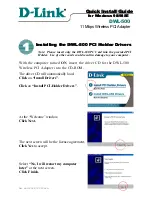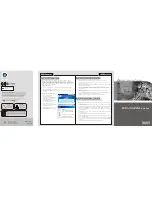
R E D U C I N G M O N I T O R I N G L A T E N C Y
108
choose a higher Samples Per Buffer setting.
Depending on your computer’s CPU speed, you
might find that settings in the middle work best
(256 to 2048).
Transport responsiveness
The Samples Per Buffer setting also impacts how
quickly your audio software will respond when you
begin playback, although not by amounts that are
very noticeable. Lowering the Samples Per Buffer
will make your software respond faster; raising the
Samples Per Buffer will make it a little bit slower,
but barely enough to notice.
Effects processing and automated mixing
Reducing latency with the Samples Per Buffer
setting has another benefit: it lets you route live
inputs through the real-time effects processing and
mix automation of your audio software.
CUEMIX DSP HARDWARE MONITORING
The PCI-424 card has a more direct method of
patching audio through the system. This method is
called
CueMix DSP
. When enabled, CueMix
activates hardware patch-thru in the PCI-424 card
itself. CueMix DSP has two important benefits:
■
First, it completely eliminates the patch thru
delay (reducing it to a small number of samples —
about the same amount as one of today’s digital
mixers).
■
Secondly, CueMix DSP imposes no strain on the
computer.
The trade-off, however, is that CueMix DSP
bypasses your host audio software. Instead, live
audio inputs are patched directly through to
outputs in the PCI-424 card itself and are mixed
with disk tracks playing back from your audio
software. This means that you cannot apply
plug-ins, mix automation, or other real-time
effects that your audio software provides. But for
inputs that don’t need these types of features,
CueMix DSP is the way to go.
On the other hand, if you really need to use the
mixing and processing provided by your audio
software, you should not use CueMix DSP. Instead,
reduce latency with the
Samples Per Buffer
setting
(as explained earlier in this chapter).
TWO METHODS FOR CONTROLLING
CUEMIX DSP
If you are using Digital Performer, AudioDesk or
ASIO-compatible audio software, there are two
ways to control CueMix DSP:
■
From AudioDesk, Digital Performer, or your
ASIO-compatible host software
■
From CueMix Console
You can even use both methods simultaneously.
Controlling CueMix DSP from your audio
software
Follow the directions below in the section that
applies to you.
Controlling CueMix from within AudioDesk or
Digital Performer
To turn on CueMix DSP in AudioDesk and Digital
Performer:
1
From the Basics menu, choose
MOTU Audio
System options>Input Monitoring Mode
.
2
Choose the
Direct hardware playthrough
option,
as shown below in Figure 12-4.
3
From the Windows menu, choose
Audio
Monitor
, and enable Audio Patch Thru (the button
with the headphone icon on it).
Содержание PCI-424
Страница 35: ...6 ...
Страница 43: ...14 ...
Страница 45: ...16 ...
Страница 53: ...P A C K I N G L I S T A N D P C S Y S T E M R E Q U I R E M E N T S 24 ...
Страница 83: ...I N S T A L L I N G T H E P C I 4 2 4 H A R D W A R E 54 ...
Страница 103: ...M O T U P C I A U D I O C O N S O L E 74 ...
Страница 111: ...C U B A S E N U E N D O A N D O T H E R A S I O S O F T W A R E 82 ...
Страница 115: ...S O N A R A N D O T H E R W D M S O F T W A R E 86 ...
Страница 119: ...E X P A N D I N G Y O U R P C I 4 2 4 S Y S T E M 90 ...
Страница 125: ...R E D U C I N G M O N I T O R I N G L A T E N C Y 96 ...
Страница 131: ...C U E M I X C O N S O L E 102 ...
Страница 148: ...6 ...
Страница 156: ...14 ...
Страница 158: ...16 ...
Страница 166: ...P A C K I N G L I S T A N D M A C I N T O S H S Y S T E M R E Q U I R E M E N T S 24 ...
Страница 194: ...I N S T A L L I N G T H E P C I 4 2 4 H A R D W A R E 52 ...
Страница 230: ...A U D I O D E S K 88 ...
Страница 246: ...E X P A N D I N G Y O U R P C I 4 2 4 S Y S T E M 104 ...
Страница 258: ...C U E M I X C O N S O L E 116 ...
















































